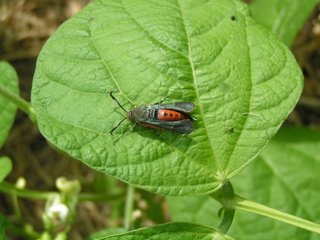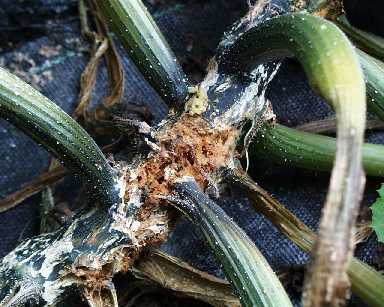PESTS and PESTILENCE
Squash Vine Borer
The squash vine borer is by far the worst insect pest I have in the garden. In the "pestilence" category, I think the potato blight is probably the worst (see below). The attractive insect below is in the order Lepidoptera, though it actually looks like a fly (diptera). I start spotting it around the garden in may.
Squash Vine Borer
The squash vine borer is by far the worst insect pest I have in the garden. In the "pestilence" category, I think the potato blight is probably the worst (see below). The attractive insect below is in the order Lepidoptera, though it actually looks like a fly (diptera). I start spotting it around the garden in may.
 Squash vine borers refers to the larva of the moth pictured above. This insects lays its eggs on the stems of squash plants and when they hatch, they burrow into the stem and suck the juices from the plant. The first sign of damage is a generalized wilting of the plant. The first time I saw it I thought it was some sort of bacterial wilt. Later, as the borer continues to feed, it destroys some or all of the stem (shown below)
Squash vine borers refers to the larva of the moth pictured above. This insects lays its eggs on the stems of squash plants and when they hatch, they burrow into the stem and suck the juices from the plant. The first sign of damage is a generalized wilting of the plant. The first time I saw it I thought it was some sort of bacterial wilt. Later, as the borer continues to feed, it destroys some or all of the stem (shown below) At this stage your squash plant is basically dead. One single borer will kill the entire plant. I have developed a special loathing for this bug and it has forced me to modify my gardening tactics.
At this stage your squash plant is basically dead. One single borer will kill the entire plant. I have developed a special loathing for this bug and it has forced me to modify my gardening tactics.Control:
Another reason the squash vine borer is so frustrating is that you can't do much about an infestation once it has set in. First thing you notice the wilt, you have a couple options. Application of organic pesticides or biological controls to the outside of the plant will not work b/c the borer is inside the stem. So... you can either 1) Slit the stem open at the site of entry of the borer [which is identified by the browned site of damage] and use a toothpick to find and kill the borer. 2) You can inject the stems of the plant with one of several biological control agents. Bacillus thuringensis and some parasitic nematodes are available for this purpose. 3) Finally, you can cut your losses, pull up the entire plant and try to start and new crop in its location.
The first two option are not guaranteed to work by any means. I have done surgery on 5 separate plants and only come up with one fat borer.

So instead of putting a bunch of work into controlling the squash vine borer once an infestation has occurred, I focus on prevention. There is a list of squash that are most or less susceptible to the insect and butternut squash and yellow summer squash are ranked as the most resistant. Consequently, that is mostly what I grow.
I have also read that spraying the base of the plants with a mix of rotenone and pyrethrin (both plant derived organic insecticides) has a deterrent effect. I also pile dirt on stems of plants that display squash vine borer damage in the hopes that new roots will sprout and feed the remainder of the plant.

0 Comments:
Post a Comment
<< Home